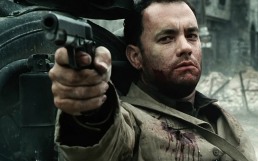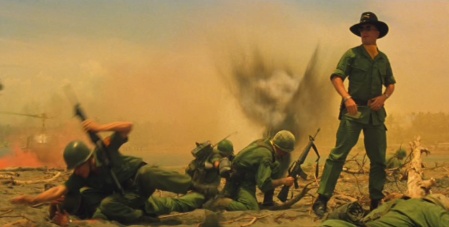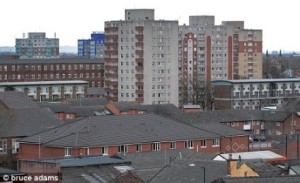I am going to use my primary photos were I used different framing techniques and compare them against secondary iconic film stills in order to see what sort of differences there are if any.
This is a secondary source still from a scene in ‘The Shining’ it uses natural framing to draw focus towards the subjects face, it uses a medium close up to show the emotion on the characters face. This is iconic because this is the scene that comes to mind whenever the film is mentioned, the saying that goes along with this scene also has a part in making this scene iconic.
The photo next to it I took at the college these two are slightly similar in that they are both medium close-ups and show the emotion on the subjects face. The still from the film has a better effect than the one I took as mine was in an everyday environment, whereas the film still was shot in a professional movie set and had better access
The difference between these two images are big, the primary source is produced by me so I had full control over every aspect of it and in this case it was the type of shot I used. On the other hand I didn’t have access to professional actors or locations to make the shot complete. I also had limitations to what I was able to do, such as in the primary source a hole in the door has been made and used as natural framing however I was unable to do this as I was at a public college.
The secondary image has the strength of natural framing, the primary image doesn’t use that instead the background is out of focus. This does a similar job of focusing all the attention towards the subject but not as good because you can still make out the background and the subjects surroundings which is a little distracting.
The acting in these to images are completely different the secondary has definitely got the strongest. In the primary image produced by me the subject is a fellow student without much acting experience, whereas the secondary has professional actor Jack Nicholson who has been in the acting career for a long time and has a lot of experience.
This shot from ‘Saving Private Ryan’ uses a lot of the rules of composition such as, depth of field, rule of thirds and looking into space. Depth of field is used in this shot to focus on the subjects face. The subject is looking into space to represent that something is coming, a medium close up is used with this so we can see the subjects emotion to try to understand what is coming.
The photo next to it is another image I took at the college using depth of field, it has the same effect as the background is blurred which bring out the subjects face and emotion. The shot type medium close up is another similarity between these two images as they both cut of at the shoulder area.
The photo on the right is primary which means I had full control over what the outcome will look like and how much depth of field I used. However the one on the left is secondary which means I don’t have any control over so I wont be able to get exactly what I want out of the photo.
Both images use depth of field however I believe the secondary image I took uses it better as more of the background is in shot which put the subject in better context. The primary image has a small corner out of focus and also the end of the subjects gun.
This is a scene from ‘Saw’ where the use very obvious rule of thirds and is a medium long shot. This shot uses a medium long shot to make sure everything of importance is in the scene, the character, the saw and the characters foot chained to the pole. The use of rule of thirds tie in with the shot type as everything is positioned perfectly.
These two images uses rule of thirds the same way, to the left is the subject which is the focus of the image, and to the right is there surroundings. the use of medium long shots are similar as well as both subjects feet are mostly out of frame.
The only down side is the lack of props and locations. on the right is primary source produced by me. I am at a college which doesn’t have a range of props to use for the scene and I am restricted to one location whereas the producer of the primary source is a professional and has access to a variety of props and locations.
The use of rule of thirds in the secondary image was a lot better than it was in the primary image, this is because in the secondary image there is no real context of what the subject is doing there. However the primary image explains itself pretty clearly and also portrays the character is planning on doing very well.
This scene from ‘Pulp Fiction’ uses rules of thirds and looking into space. The still from the scene contains two subjects both in perfect positions for the rule of thirds, they’re both looking into space which creates the impression they are looking at someone or something they are also aiming their guns slightly downwards which suggest there in a powerful position.
The photo I took at the college is side by side with the film still, they are similar as they both use the rule of thirds and looking into space. there also both medium long shots as the subjects both cut of at the knees.
The scene on the right is a primary source produced by me, I am at the college and cannot block of areas for a shoot as people need to get to there classes. However the scene to the left is produced by a professional company who can rent out private locations to film.
The image on the left is from the film ‘The Good, the Bad and the Ugly’ it uses an extreme close up to really show the emotion of the subjects eyes and sometimes the reaction shot.
The one to the right is a primary source that I took which is a lot similar to the movie still, they both use extreme close-ups and have the same emotion in their eyes and have shadows over their eyes.
These two photos are very similar, it doesn’t matter that I don’t have access to professional actors or locations because it is an extreme close up and you can’t see the background in the shot or put the subject in context. They both do a good job of showing how the character is feelings.
This was very interesting to see how similar a photo can look just by using the same techniques but different locations and actors. On the other hand how different it looks by just changing one aspect such as lighting.

![IMG_1754[1]](https://declanbaxterfilmandtelevision.files.wordpress.com/2015/09/img_17541.jpg?w=266&h=177)

![IMG_1762[1]](https://declanbaxterfilmandtelevision.files.wordpress.com/2015/09/img_17621.jpg?w=242&h=161)

![IMG_1759[1]](https://declanbaxterfilmandtelevision.files.wordpress.com/2015/09/img_17591.jpg?w=220&h=146)

![IMG_1765[1]](https://declanbaxterfilmandtelevision.files.wordpress.com/2015/09/img_17651.jpg?w=227&h=151)

![IMG_1757[1]](https://declanbaxterfilmandtelevision.files.wordpress.com/2015/09/img_17571.jpg?w=254&h=169)





![IMG_1745[1]](https://declanbaxterfilmandtelevision.files.wordpress.com/2015/09/img_17451.jpg?w=300&h=200)
![IMG_1746[1]](https://declanbaxterfilmandtelevision.files.wordpress.com/2015/09/img_17461.jpg?w=300&h=200)
![IMG_1747[1]](https://declanbaxterfilmandtelevision.files.wordpress.com/2015/09/img_17471.jpg?w=300&h=200)
![IMG_1748[1]](https://declanbaxterfilmandtelevision.files.wordpress.com/2015/09/img_17481.jpg?w=300&h=200)
![IMG_1749[1]](https://declanbaxterfilmandtelevision.files.wordpress.com/2015/09/img_17491.jpg?w=300&h=200)
![IMG_1750[1]](https://declanbaxterfilmandtelevision.files.wordpress.com/2015/09/img_17501.jpg?w=300&h=200)
![IMG_1753[1]](https://declanbaxterfilmandtelevision.files.wordpress.com/2015/09/img_17531.jpg?w=300&h=200)
![IMG_1754[1]](https://declanbaxterfilmandtelevision.files.wordpress.com/2015/09/img_17541.jpg?w=300&h=200)
![IMG_1755[1]](https://declanbaxterfilmandtelevision.files.wordpress.com/2015/09/img_17551.jpg?w=300&h=200)
![IMG_1757[1]](https://declanbaxterfilmandtelevision.files.wordpress.com/2015/09/img_17571.jpg?w=300&h=200)
![IMG_1758[1]](https://declanbaxterfilmandtelevision.files.wordpress.com/2015/09/img_17581.jpg?w=300&h=200)
![IMG_1759[1]](https://declanbaxterfilmandtelevision.files.wordpress.com/2015/09/img_17591.jpg?w=300&h=200)
![IMG_1760[1]](https://declanbaxterfilmandtelevision.files.wordpress.com/2015/09/img_17601.jpg?w=300&h=200)
![IMG_1762[1]](https://declanbaxterfilmandtelevision.files.wordpress.com/2015/09/img_17621.jpg?w=300&h=200)
![IMG_1763[1]](https://declanbaxterfilmandtelevision.files.wordpress.com/2015/09/img_17631.jpg?w=300&h=200)
![IMG_1765[1]](https://declanbaxterfilmandtelevision.files.wordpress.com/2015/09/img_17651.jpg?w=300&h=200)